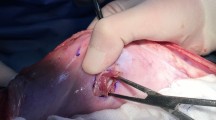Abstract
After laparoscopic ventral hernia repair, the nature of the adhesions to fixation materials or to mesh had not been clarified. We examined adhesion formation specific to the fixation material in rats. We designed an experimental laparoscopy setup, and placed four intraperitoneal fixation materials on the peritoneum of rats without a mesh graft. Another group of researchers documented the incidence and intensity of postoperative adhesion formation. The adhesion scores for the nickel-titanium anchor were significantly greater than those for polylactic acid (p = 0.004), a titanium tacker (p < 0.0001), and fibrin glue (p < 0.0001). No adhesions occurred in the fibrin glue group. Fibrin glue is the preferred fixation material because it produced no postoperative adhesions. The nickel-titanium anchor produced heavy adhesions but may be applicable for recurrent hernia cases and in patients with thin abdominal walls.






Similar content being viewed by others
References
Lanzafame RJ, Stadler I, Brondon P, Soltz BA, Devore DP (2005) Preliminary assessment of postoperative adhesion formation after laser assisted mesh fixation to the peritoneal surface. J Laparoendoscopic Adv Surg Tech A 15(2):105–111
Joels CS, Matthews BD, Kercher KW, Austin C, Norton HJ, Williams TC, Heniford BT (2005) Evaluation of adhesion formation, mesh fixation strength and hydroxyproline content after intraabdominal placement of polytetrafluoroethylene mesh secured using titanium spiral tacks, nitinol anchors, and polypropylene suture or polyglactin 910 suture. Surg Endosc 19(6):780–785
Novitsky YW, Harrell AG, Cristiano JA, Paton BL, Norton HJ, Peindl RD, Kercher KW, Heniford BT (2007) Comparative evaluation of adhesion formation, strength of ingrowth, and textile properties of prosthetic meshes after long term intraabdominal implantation in a rabbit. J Surg Res 140:6–11
Kayaoğlu HA, Özkan N, Hazinedaroğlu SM, Ersoy ÖF, Erkek AB, Köseoğlu RD (2005) Comparison of adhesive properties of five different prosthetic materials used in hernioplasty. J Invest Surg 18(2):89–95
Conze J, Junge K, Klinge U, Weiss C, Polivoda M, Oettinger AP, Schumpelick V (2005) Intraabdominal adhesion formation of polypropylene mesh, influence of coverage of omentum and polyglactin. Surg Endosc 19(6):798–803
Eller R, Twaddell C, Poulos E, Jenevein E, McIntire D, Russell S (1994) Abdominal adhesions in laparoscopic hernia repair- an experimental study. Surg Endosc 8:181–184
Mc Ginty JJ, Hogle NJ, Mc Carthy H, Fowler DL (2005) A comparative study of adhesion formation and abdominal wall ingrowth after laparoscopic ventral hernia repair in a porcine model using multiple types of mesh. Surg Endosc 19:786–790
Malazgirt Z, Ulusoy AN, Gok Y, Karagoz F, Tac K (2000) Bioabsorbable membrane prevents adhesions to polypropylene mesh in rats. Hernia 4:129–133
Le Blanc KA, Stout RW, Kearney MT, Paulson DB (2003) Comparison of adhesion formation associated with Pro-Tack (US Surgical) vs a new mesh fixation device, Salute (ONUX Medical). Surg Endosc 17:1409–1417
Borrazzo EC, Belmont MF, Boffa D, Fowler DI (2004) Effect of prosthetic material on adhesion formation after laparoscopic ventral hernia repair in a porcine model. Hernia 8:108–112
Karahasanoğlu T, Onur E, Baca B, Hamzaoğlu I, Pekmezci S, Boler DE, Kılıç N, Altuğ N (2004) Spiral tacks may contribute to intraabdominal adhesion formation. Surg Today 34:860–864
Winslow ER, Diaz S, Desai K, Meininger T, Soper NJ, Klingensmith ME (2004) Laparoscopic incisional hernia repair in a porcine model: what do transfixion sutures add? Surg Endosc 18(3):529–535
Mazuji MK, Fadhli HA (1965) Peritoneal adhesions; prevention with povidone and dextran 75. Arch Surg 91(6):872–874
Avital S, Bollinger TJ, Wilkinson JD, Marchetti F, Hellinger MD, Sands LR (2005) Preventing intraabdominal adhesions with polylactic acid film: an animal study. Dis Colon Rectum 48(1):153–157
Attwood SEA, Caldwell MTP, Marks P, McDermott M, Stephens RB (1994) Adhesions after laparoscopic inguinal hernia repair. A comparison of extra versus intra peritoneal placement of a polypropylene mesh in an animal model. Surg Endosc 8:777–780
Zong X, Li S, Chen E, Garlick B, Kim KS, Fang D, Chiu J, Zimmerman T, Brathwaite C, Hsiao BS, Chu B (2004) Prevention of postsurgery-induced abdominal adhesions by electrospun bioabsorbable nanofibrous poly(lactide-co-glycolide)-based membranes. Ann Surg 240(5):910–915
Baykal A, Onat D, Raşa K, Renda N, Sayek I (1997) Effects of polyglycolic acid and polypropylene meshes on postoperative adhesion formation in mice. World J Surg 21:579–583
Duffy AJ, Hogle NJ, LaPerle KM, Fowler DI (2004) Comparison of two composite meshes using two fixation devices in a porcine laparoscopic ventral hernia repair model. Hernia 8:358–364
Saed GM, Kruger M, Diamond MP (2004) Expression of transforming growt factor –beta and extracellular matrix by human peritoneal mesothelial cells and by fibroblasts from normal peritoneum and adhesions: effect of Tisseel. Wound Repair Regen 12(5):557–564
Katkhouda N (2004) A new technique for laparoscopic hernia repair using fibrin sealant. Surg Technol Int 12:120–126
Schulze S, Kristiansen VB, Hansen BF, Rosenberg J (2005) Biological tissue adhesive for mesh application in pigs. Surg Endosc 19:342–344
Gonzales R, Rodeheaver GT, Moody DL, Foresman PA, Ramshaw BJ (2004) Resistance to adhesion formation: a comparative study of treated and untreated mesh products placed in the abdominal cavity. Hernia 8:213–219
Author information
Authors and Affiliations
Corresponding author
Rights and permissions
About this article
Cite this article
Gungor, B., Malazgirt, Z., Topgül, K. et al. Comparative Evaluation of Adhesions to Intraperitoneally Placed Fixation Materials: A Laparoscopic Study in Rats. Indian J Surg 72, 475–480 (2010). https://doi.org/10.1007/s12262-010-0168-3
Received:
Accepted:
Published:
Issue Date:
DOI: https://doi.org/10.1007/s12262-010-0168-3




